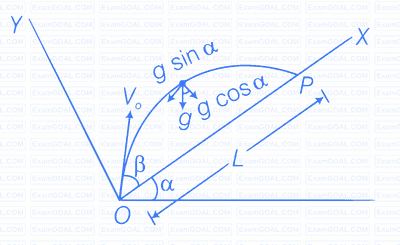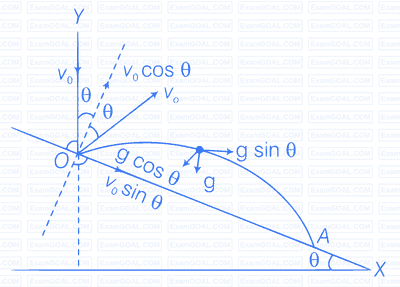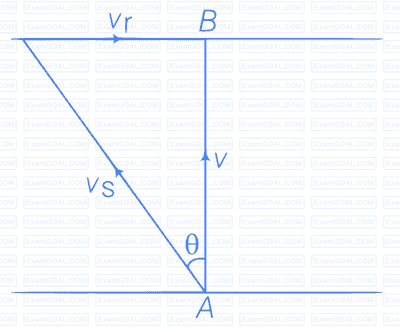A gun can fire shells with maximum speed $v_0$ and the maximum horizontal range that can be achieved is $R = \dfrac{v_0^2}{g}$ If a target farther away by distance $\Delta x$ (beyond $R$) has to be hit with the same gun, show that it could be achieved by raising the gun to a height at least
$h = \Delta x \left[1 + \dfrac{\Delta x}{R}\right]$

This problem can be approached in two different ways
(i) Refer to the diagram, target $T$ is at horizontal distance $x = R + \Delta x$ and between point of projection $y = -h$.
(ii) From point $P$ in the diagram projection at speed $v_0$ at an angle $\theta$ below horizontal with height $h$ and horizontal range $\Delta xA$)
Applying method (i)
Maximum horizontal range
$$R = \frac{{v_0^2}}{g}, \text{ for } \theta = 45^\circ\quad \text{...(i)}$$
Let the gun be raised through a height h from the ground so that it can hit the target. Let vertically downward direction be taken as positive.
Horizontal component of initial velocity = v0 cosθ
Vertical component of initial velocity = −v0 sinθ
Taking motion in vertical direction,
$ h = (-v_0 \sin\theta) \, t + \frac{1}{2} \, g \, t^2 $ ... (ii)
Taking motion in horizontal direction
$(R + Δx) = v_0 \cos\theta \times t $
$\Rightarrow$ $ t = \frac{(R + Δx)}{v_0 \cos\theta} $ ... (iii)
Substituting value of t in Eq. (ii), we get
$ \begin{align*} h &= \left(-v_0 \sin\theta \right) \times \left( \frac{R + Δx}{v_0 \cos\theta} \right) + \frac{1}{2} \, g \, \left( \frac{R + Δx}{v_0 \cos\theta} \right)^2 \\ h &= - (R + Δx) \tan\theta + \frac{1}{2} \, g \, \frac{(R + Δx)^2}{v_0^2 \cos^2\theta} \end{align*} $
$\begin{align*} &\text{As angle of projection is } \theta = 45^\circ, \text{ therefore} \\\\ & h = -(R + \Delta x) + \tan 45^\circ + \frac{1}{2} \frac{g\ (R + \Delta x)^2}{v_0^2 \cos^2 45^\circ} \\\\ & h = -(R + \Delta x) \times 1 + \frac{1}{2} \frac{g \ (R + \Delta x)^2}{v_0^2 (1/2)} \quad \left(\because \tan 45^\circ = 1 \text{ and } \cos 45^\circ = \frac{1}{\sqrt{2}}\right) \\\\ & h = -(R + \Delta x) + \frac{(R + \Delta x)^2}{R} \quad \text{[Using Eq. (i), } R = \frac{v_0^2}{g}] \\\\ & = -(R + \Delta x) + \frac{1}{R}(R^2 + \Delta x^2 + 2R\Delta x) \\\\ & = -R - \Delta x + \left( R + \frac{\Delta x^2}{R} + 2\Delta x \right) \\\\ & = \Delta x + \frac{\Delta x^2}{R} \\\\ & h = \Delta x \left( 1 + \frac{\Delta x}{R} \right) \\\\ & \text{Hence proved.} \end{align*}$
Note We should not confuse with the positive direction of motion. May be vertically upward direction or vertically downward direction is taken as positive according to convenience.
A particle is projected in air at an angle $\beta$ to a surface which itself is inclined at an angle $\alpha$ to the horizontal (figure).
(a) Find an expression of range on the plane surface (distance on the plane from the point of projection at which particle will hit the surface).
(b) Time of flight.

Consider the adjacent diagram.
Mutually perpendicular x and y-axes are shown in the diagram.
Particle is projected from the point O.
Let time taken in reaching from point O to point P is T.
(b) Considering motion along vertical upward direction perpendicular to OX.
For the journey O to P.
$ \begin{align*} & y = 0, \ u_y = v_0 \sin \beta, \ a_y = -g \cos \alpha, \ t = T \\ & \text{Applying equation,} \\ & y = u_y t + \frac{1}{2} a_y t^2 \\ & \implies 0 = v_0 \sin \beta T + \frac{1}{2}(-g \cos \alpha) T^2 \end{align*} $
$\Rightarrow \ T \left[ v_0 \sin \beta - \frac{g \cos \alpha}{2} T \right] = 0 $
$\Rightarrow \quad T = 0, \ T = \frac{2\ v_0 \sin \beta}{g \cos \alpha} $
As $ T = 0 $, corresponding to point $ O $
Hence, $T = \text{Time of flight} = \frac{2\ v_0 \sin \beta}{g \cos \alpha} $
(a)$\text{ Considering motion along } OX.$
$ x = L, u_x = v_0 \cos \beta, a_x = -g \sin \alpha $
$ t = T = \frac{2\ v_0 \sin \beta}{g \cos \alpha} $
$ x = u_x t + \frac{1}{2} a_x t^2 $
$\begin{align*} \implies & \quad L = v_0 \cos \beta \ T + \frac{1}{2} (-g \sin \alpha) \ T^2 \\\\ \implies & \quad L = v_0 \cos \beta \ T - \frac{1}{2} g \sin \alpha \ T^2 \\\\ & \quad = T \left[v_0 \cos \beta - \frac{1}{2} g \sin \alpha \ T \right] \\\\ & \quad = T \left[ v_0 \cos \beta - \frac{1}{2} g \sin \alpha \times \frac{2 v_0 \sin \beta}{g \cos \alpha} \right] \\\\ & \quad = \frac{2 \ v_0 \sin \beta}{g \cos \alpha} \left[ v_0 \cos \beta - \frac{v_0 \sin \alpha \sin \beta}{\cos \alpha} \right] \\\\ & \quad = \frac{2 \ v_0^2 \sin \beta}{g \cos^2 \alpha} [\cos \beta \cdot \cos \alpha - \sin \alpha \cdot \sin \beta] \\\\ \implies & \quad L = \frac{2 \ v_0^2 \sin \beta}{g \cos^2 \alpha} \cos (\alpha + \beta) \end{align*}$
$(c)$ For range $(L)$ to be maximum, $ \sin \beta \cdot \cos (\alpha + \beta) $ should be maximum.
Let,
$ \begin{align*} Z &= \sin \beta \cdot \cos (\alpha + \beta) \\ &= \sin \beta \left[ \cos \alpha \cdot \cos \beta - \sin \alpha \cdot \sin \beta \right] \\ &= \frac{1}{2} \left[ \cos \alpha \cdot \sin 2\beta - 2 \sin \alpha \cdot \sin^2 \beta \right] \\ &= \frac{1}{2} \left[ \sin 2 \beta \cdot \cos \alpha - \sin \alpha \left(1 - \cos 2 \beta\right) \right] \\ \implies z &= \frac{1}{2} \left[ \sin 2 \beta \cdot \cos \alpha - \sin \alpha + \sin \alpha \cdot \cos 2 \beta \right] \\ &= \frac{1}{2} \left[ \sin 2 \beta \cdot \cos \alpha + \cos 2 \beta \cdot \sin \alpha - \sin \alpha \right] \\ &= \frac{1}{2} \left[ \sin (2 \beta + \alpha) - \sin \alpha \right] \end{align*} $
For $z$ to be maximum,
$ \sin (2 = \beta + \alpha) = \text{maximum} = 1 $
$ \implies 2 \beta + \alpha = \frac{\pi}{2} \text{ or, } \beta = \frac{\pi}{4} - \frac{\alpha}{2} $
A particle falling vertically from a height hits a plane surface inclined to horizontal at an angle $\theta$ with speed $v_0$ and rebounds elastically. Find the distance along the plane where it will hit second time.


Considering x and y-axes as shown in the diagram. For the motion of the projectile from O to A.
$ y = 0, u_y = v_0 \cos \theta \\ a_y = -g \cos \theta, t = T $
Applying equation of kinematics,
$ y = u_y t + \frac{1}{2} a_y t^2 $
$ ⇒ \quad 0 = v_0 \cos \theta \; T + \frac{1}{2}(-g \cos \theta) T^2 $
$ ⇒ \quad T \left[ v_0 \cos \theta - \frac{g \cos \theta \; T}{2} \right] = 0 $
$ T = \frac{2 v_0 \cos \theta}{g \cos \theta} $
As $T = 0$, corresponds to point $O$
Hence,
$ T = \frac{2v_0}{g} $
Now considering motion along $OX$.
$ x = L, \ u_x = v_0 \sin \theta, \ a_x = g \sin \theta, \ t = T = \frac{2v_0}{g} $
Applying equation of kinematics,
$ x = u_x t + \frac{1}{2} a_x t^2 $
$ \Rightarrow L = v_0 \sin \theta \ t + \frac{1}{2} g \sin \theta \ t^2 = (v_0 \sin \theta) (T) + \frac{1}{2} g \sin \theta \ T^2 $
$ \qquad = (v_0 \sin \theta) \left( \frac{2v_0}{g} \right) + \frac{1}{2} g \sin \theta \times \left( \frac{2v_0}{g} \right)^2 $
$ \qquad = \frac{2v_0^2}{g} \sin \theta + \frac{1}{2} g \sin \theta \times \frac{4v_0^2}{g^2} = \frac{2v_0^2}{g} [\sin \theta + \sin \theta] $
$ \Rightarrow L = \frac{4v_0^2}{g} \sin \theta $
A girl riding a bicycle with a speed of 5 m/s towards north direction, observes rain falling vertically down. If she increases her speed to 10 m/s, rain appears to meet her at 45° to the vertical. What is the speed of the rain? In what direction does rain fall as observed by a ground-based observer?

Assume north to be $ \hat{i} $ direction and vertically downward to be $-\hat{j} $.
Let the rain velocity $ \mathbf{v}_r $ be $ a \hat{i} + b \hat{j} $.
$\mathbf{v}_r = a \hat{i} + b \hat{j} $
Case I Given velocity of girl = $ \mathbf{v}_g = (5 \text{ m/s})\hat{i} $
Let $ \mathbf{v}_{rg} $ = Velocity of rain w.r.t girl
$ \mathbf{v}_{rg} = \mathbf{v}_r - \mathbf{v}_g = (a\hat{i} + b\hat{j}) - 5\hat{i} $
$ = (a - 5) \hat{i} + b \hat{j} $
According to question rain, appears to fall vertically downward. Hence,
$ a - 5 = 0 \Rightarrow a = 5 $
Case II Given velocity of the girl, $ \mathbf{v_g} = (10 \text{ m/s}) \hat{i} $
$ \mathbf{v_{rg}} = \mathbf{v_r} - \mathbf{v_g} $
$ = (a\hat{i} + b\hat{j}) - 10\hat{i} = (a - 10)\hat{i} + b\hat{j} $
According to question rain appears to fall at 45° to the vertical hence $ \tan 45° = \frac{b}{a - 10} = 1 $
$ \Rightarrow b = a - 10 = 5 - 10 = -5 $
Hence, velocity of rain $ = a\hat{i} + b\hat{j} $
$ \Rightarrow \mathbf{v_r} = 5\hat{i} - 5\hat{j} $
Speed of rain = $|\mathbf{v_r}| = \sqrt{(5)^2 + (-5)^2} = \sqrt{50} = 5\sqrt{2} \text{ m/s} $
A river is flowing due east with a speed 3 m/s. A swimmer can swim in still water at a speed of 4 m/s (figure).
(a) If swimmer starts swimming due north, what will be his resultant velocity (magnitude and direction)?
(b) If he wants to start from point A on south bank and reach opposite point B on north bank,
(i) which direction should he swim?
(ii) what will be his resultant speed?
(c) From two different cases as mentioned in (a) and (b) above, in which case will he reach opposite bank in shorter time?

Given, Speed of the river $(v_r) = 3 \text{ m/s (east)}$
Speed of swimmer $(v_s) = 4 \text{ m/s (east)}$
(a) When swimmer starts swimming due north then his resultant velocity

$ v = \sqrt{v_r^2 + v_s^2} = \sqrt{(3)^2 + (4)^2} $
$ = \sqrt{9 + 16} = \sqrt{25} = 5 \text{ m/s} $
$ \tan \theta = \frac{v_r}{v_s} = \frac{3}{4} $
$ = 0.75 = \tan 36^\circ 54' $
Hence,
$ \theta = 36^\circ 54' \text{ N} $
(b) To reach opposite points B, the swimmer should swim at an angle $ \theta $ of north. Resultant speed of the swimmer

$ v = \sqrt{v_s^2 - v_r^2} = \sqrt{(4)^2 - (3)^2} \\ = \sqrt{16 - 9} = \sqrt{7} \text{ m/s} $
$ \tan \theta = \frac{v_r}{v} = \frac{3}{\sqrt{7}} $
$\Rightarrow \quad \theta = \tan^{-1} \left( \frac{3}{\sqrt{7}} \right) \text{ of north} $
(c) In case (a),
Time taken by the swimmer to cross the river, $ t_1 = \frac{d}{v_s} = \frac{d}{4} $
In case (b),
Time taken by the swimmer to cross the river
$ t_1 = \frac{d}{v} = \frac{d}{\sqrt{7}} $
As
$ \frac{d}{4} < \frac{d}{\sqrt{7}}, \text{ therefore } t_1 < t_2 $
Hence, the swimmer will cross the river in shorter time in case (a).